- Home
- Isaac Hooke
ATLAS 3 (ATLAS Series Book 3)
ATLAS 3 (ATLAS Series Book 3) Read online
BOOKS BY ISAAC HOOKE
ATLAS Series
ATLAS
ATLAS 2
ATLAS 3
Caterpillar Without a Callsign
(A novella about Snakeoil’s heroism on his first deployment)
Just Another Day
(A novella about Facehopper’s encounter with the infamous privateer Mao Sing Ming)
The Ford
(A novella about Commodore Hanson’s resignation and the battle in orbit while the MOTHs fought below)
Forever Gate Serial
Forever Gate 1
Forever Gate 2
Forever Gate 3
Forever Gate 4
Forever Gate 5
Forever Gate Compendium (Parts 1–5)
Other Works
Finding Harmon (Short Story)
This is a work of fiction. Names, characters, organizations, places, events, and incidents are either products of the author’s imagination or are used fictitiously.
Text copyright © 2015 Isaac Hooke
All rights reserved.
No part of this book may be reproduced, or stored in a retrieval system, or transmitted in any form or by any means, electronic, mechanical, photocopying, recording, or otherwise, without express written permission of the publisher.
Published by 47North, Seattle
www.apub.com
Amazon, the Amazon logo, and 47North are trademarks of Amazon.com, Inc., or its affiliates.
ISBN-13: 9781477828670
ISBN-10: 1477828672
Cover illustration by Justin Adams
Library of Congress Control Number: 2014957824
CONTENTS
PROLOGUE
CHAPTER ONE
CHAPTER TWO
CHAPTER THREE
CHAPTER FOUR
CHAPTER FIVE
CHAPTER SIX
CHAPTER SEVEN
CHAPTER EIGHT
CHAPTER NINE
CHAPTER TEN
CHAPTER ELEVEN
CHAPTER TWELVE
CHAPTER THIRTEEN
CHAPTER FOURTEEN
CHAPTER FIFTEEN
CHAPTER SIXTEEN
CHAPTER SEVENTEEN
CHAPTER EIGHTEEN
CHAPTER NINETEEN
CHAPTER TWENTY
CHAPTER TWENTY-ONE
CHAPTER TWENTY-TWO
CHAPTER TWENTY-THREE
CHAPTER TWENTY-FOUR
CHAPTER TWENTY-FIVE
CHAPTER TWENTY-SIX
CHAPTER TWENTY-SEVEN
EPILOGUE
ABOUT THE AUTHOR
PROLOGUE
Shaw looked through the cockpit window.
She was some eight thousand one hundred lightyears from home, the farthest from Earth any human being had ever traveled. The intrepid spirit in her was happy. Living the dream. But the other part of her, the side that missed human contact and yearned for the feel of green grass beneath her feet and the caress of a fresh breeze against her face, wasn’t so happy.
She wanted to go back to Earth. But she couldn’t.
Not until she was finished out here.
She couldn’t shake a growing sense of unease as she gazed from that window. None of the constellations in this alien quadrant were familiar to her. Though to call this region “alien” was probably a misnomer: Here, she was the invader. The alien.
But that’s not what bothered her.
The blue-white sphere that ate up the view below took full credit for that.
It was a sun.
Or at least, it once was.
Now it was just a large mass of inert gas. For all intents and purposes, it should have been blindingly bright at this range. According to the galactic charts stored in her aReal, it had been classified as a G-type main sequence star, the same as Earth’s sun. True, eight thousand one hundred years had passed since its light had reached the extrasolar observatories of humankind responsible for categorizing the star, but even so it should have had enough fuel to last at least another five billion years in the G state.
Yet here it sat, dead. A white dwarf, fusionless, its dense, Earth-sized mass supported only by electron degeneracy pressure. It was surrounded by a hollow sphere of cast-off nebular gases having a diameter of approximately two AU. The blue-white light the dead star emitted came not from fusion but rather from its stored heat, which would slowly radiate away over the next trillion years, never to be replenished.
Some external force had prematurely accelerated its life cycle, killing the star. The Phants were to blame somehow, Shaw knew, but she didn’t understand the how of it, or the why.
Her eyes drifted toward a lone vessel that lay much closer than the dead star: the Foundry. It was cylindrical in shape and revolved around its central axis like an old-style Earth ship from the days before artificial gravity; she suspected the rotational motion abetted the manufacturing that went on there. No external lights illuminated the hull; the ship’s presence on the visible spectrum was due solely to the blue-white radiation cast by the star. On the thermal spectrum, however, the vessel practically glowed.
The Foundry grew in size as Shaw’s shuttle approached, so that soon the vessel’s vastness eclipsed the sun entirely. Her onboard autopilot fired compensating thrust, slowing her craft as it neared the target’s curved hull; lateral jets activated, yawing the shuttle so that the narrow aft section pointed toward the larger ship. More jets fired and the constellations shifted, drifting past in a direction perpendicular to their former motion as the shuttle revolved in a wide circle, syncing with the rotation of the Foundry.
Reverse thrusters activated; the G forces dragged Shaw forward in her seat. She felt a pinching pressure in the hip region where the waist clamps dug into her jumpsuit. Forget about inertial dampeners and supergimballed seats: her so-called allies hadn’t designed this shuttle for comfort.
Her craft shuddered as the aft section made contact with an airlock on the larger vessel. The external clamps locked into place. The fit was perfect.
The stars continued to rotate outside the cockpit window, interrupted occasionally by the blue-white orb of the dead sun. The Gs didn’t let up. Indeed, now that the shuttle was linked to the Foundry, the pull caused by the centrifugal force made the Gs feel even stronger. When she relaxed her arms, they hung down in front of her. It felt like she was strapped into a seat high up on some amusement park ride, facing directly downward.
She checked her aReal. The gravity vector read 1.2 G, pointing at the cockpit window. She suppressed a wave of nausea. Changing from zero G to any sort of gravity often evoked discomfort, especially when the preceding weightlessness lasted for any significant length of time. It didn’t help that the gravity vector was at odds with her visual perception, or that stars drifted past continually, seeming to fall upward.
She closed her eyes, took a deep breath, and then deactivated the seat clamps.
She fell immediately, crashing into the window. Unsure if the glass was rated for her weight, she meticulously pulled herself upright until she stood between the downward facing seats. It felt like she was perched on one of those observation decks with the glass floors that some space stations liked to set up to scare the living bejeebers out of visitors. Except that this glass might actually break.
She hauled herself onto the backrest of the closest seat and then pulled herself through the door that led to the extensive cargo hold beyond. Standing on the partition that separated the hold from the cockpit, she walked over to the rightmost bulkhead (
which was originally the deck, but the odd gravity vector had changed that). She climbed the rungs set into the metal.
When she reached the overhead (previously the aft bulkhead), she used the downward-hanging handgrips to pull herself along, like a kid on the monkey bars of some playground. She tried not to look down the twenty-five-meter drop to the cockpit partition, wishing the whole while that the shuttle had artificial gravity. A jetpack would have been nice right then, too, but her alien allies wanted to make things difficult for her.
“Flammable material of any kind is not allowed in the Foundry,” Azen had said. “They will not let you board if you wear a jetpack.”
Azen. The alien who had rescued her from the Phants and taken her to his homeworld. The alien who was a Phant himself: an interdimensional being whose form varied between vapor and liquid, depending on the environment. She wasn’t sure how much she could trust him. So far he had been true to his word.
So far.
She moved her hanging body forward, hand over hand, and when she was beneath the airlock, the hatch irised open automatically. A circular hole seven meters in diameter appeared above her.
The corridor beyond was completely dark, lit only by the ambient illumination from her shuttle’s cargo bay. She noticed there was no inner airlock. That made sense, given that the environments already matched. The atmospheric contents of both shuttle and Foundry weren’t much different from the void of space.
This wasn’t a place where organic life was intended to thrive.
Shaw activated the headlamp on her helmet, half expecting something to leap down and attack her. She hauled herself through the airlock and into the gloomy, expansive corridor beyond. She paused there on her knees, feeling a little winded from the monkey-bar crawl. Her breath sounded loud inside the confines of her pressurized suit.
After a moment, she planted one foot firmly on the deck and stood up, her second boot connecting with a noticeable absence of sound.
The rectangular corridor she found herself within was a veritable grand hall, given its approximately twenty-six-meter height. Fibonacci spirals etched the metal at random intervals. It was quite different from the bulkheads of intermeshed and living pipes she was used to aboard these alien vessels; she suspected it was designed by some species the Phants had conquered.
She sensed motion behind her. Glancing over her shoulder, the light from her headlamp illuminated a metallic, black shape on the opposite side of the airlock. So tall that it scraped the ceiling, the form appeared humanoid, though its body was stretched and elongated to an alien degree—the head was more oblong than round, the smooth torso formed an ellipse, the two arms and two legs were segmented ovals. The only distinguishing feature on the head was a long bar of glowing red where the eyes should have been.
It was one of the alien mechs Azen had told her about. At roughly twice the height of an ATLAS 5, its sheer size proved daunting. The tubing and bulges associated with servomotors and hydraulics were completely absent; instead there were slight circular indentations around the joint areas. Everything seemed part of one smooth, nearly seamless surface.
She didn’t see weapons of any kind, though she did spot what looked like a “mount point” on the right arm, which told her that the mech hadn’t yet been equipped with weaponry. Good. Though the very fact the thing was posted there and looking at her told Shaw that a Phant possessed it.
She stared anxiously at the mech through her faceplate for a few seconds, feeling beads of sweat roll down her forehead. Then she tentatively took one step away, then another.
The possessed mech turned its head aside and ignored her. Because of what Azen had done earlier, she would appear as a friendly.
Behind her, the deck airlock spiraled closed in ominous silence. She felt the momentary vibrations beneath her feet.
She proceeded along the Fibonacci-engraved corridor, feeling entirely out of place in that hall built for giants. It was all she could do to keep walking, and to constantly suppress the sensation that the mech was following her. A furtive glance over her shoulder told her that the thing remained in place by the airlock.
Azen had programmed the HUD (Heads-Up Display) in her helmet aReal with a map of the vessel, and she took the wide corridors and branches indicated thereupon, making her way toward a flashing waypoint.
At the indicated destination, she found a short ramp and scaled it. The bulkheads and overhead fell away so that she stood within the vast, cylindrical compartment that spanned the length of the vessel. The area had a diameter of about two klicks, so that when she looked up, the overhead seemed as distant as a high-rise or small mountain.
A sudden dread filled Shaw: Around her, rank upon rank of giant mechs covered the deck, exact replicas of the one she had seen guarding the airlock. Their vision sensors were dark, so she knew they were inactive. Still, the mechs unsettled her. Azen had warned her about this of course, but seeing them with her own eyes made everything hit home. There were just so many of them—literally thousands—arranged in organized rows and columns, crowding every visible portion of the curved deck, continuing all the way around the inside of the vast cylinder.
Looking straight up as she followed the many ranks with her eyes, she realized that what she had at first assumed to be circular adornments in the overhead were in fact more alien mechs; they stood glued in place thanks to the centrifugal force of the revolving hull, their oblong heads hanging down. Everywhere she looked she saw the things.
A mech stood watch next to her, looming just beside the ramp she had scaled. The glowing vision sensor told her it was active. This one proved unarmed as well—not that it needed weapons to rip her apart. Though just as tall as the previous mech she had encountered, it seemed somehow smaller, no doubt because of the psychological dwarfing effect caused by the vast space around it.
The cyclops-like head turned to follow Shaw as she passed. She did her best to ignore it, because other than the head motion, the mech made no attempt to interfere with her passage.
She moved deeper into the expansive compartment; those daunting black forms crowded right up to the gangway on either side, standing like metal sentries. The lack of atmosphere ensured her boots produced no sound when they touched the metallic deck, and the effect somehow comforted her. She couldn’t imagine walking through here with her boots clanging away loud enough to wake the dead.
She looked back a few times to ensure she wasn’t pursued. The alien mech remained at its post by the entrance. She wanted to put as much distance between herself and that thing as possible before she did what she had come to do. She wasn’t sure how much it really mattered though, not with those others standing watch around her, onboard AIs likely ready to spring to life at the first sign of trouble.
She walked on for ten minutes. The far side of the cylinder was still a ways off at that point, but she decided she’d gone far enough.
She glanced over her shoulder: The sentry mech was a dot in the distance and still resided by the entrance. She zoomed in on her aReal. The mech’s head wasn’t even facing her.
Shaw did a quick scan of the surrounding area, running her gaze up along the curving deck all the way to the overhead, searching for signs of any active mechs or other entities on patrol. She saw only the giant, inactive black bodies, patiently waiting to be sent to war.
She weaved between two of the inactive mechs that bordered the gangway and moved inward until she was three ranks deep. She gave the area one last look over and then, satisfied that none of the mechs observed her, she reached into the pocket of her jumpsuit and removed a fist-sized object. As nonchalantly as she could, she affixed it to the leg of the closest alien mech and input twelve minutes. She activated the timer and a countdown appeared on her HUD.
11:59. 11:58. 11:57. . . .
She returned to the gangway. She casually leaned against one of the mechs in the front ranks, letting the back of her
jumpsuit contact the tall, metallic calf area.
Azen was with her. The green Phant resided within a specially constructed graft attached to her jumpsuit, running along the spinal area. To any nearby alien entities, she would have appeared similar to a possessed human host: a body with a steel bar cybernetically attached to the skull and spine, with a Phant embedded inside the metal and in control of her mind. Her friend Fan, who had been marooned with her on Geronimo, had been converted into such a host while she watched helplessly. It wasn’t something she hoped to witness ever again.
The graft she wore was embedded into her jumpsuit, not her body, and was prevented from contacting her ventilation undergarment by some type of padding, which supposedly provided protection against Azen’s deadly touch. Ally or not, she didn’t feel all that safe with a Phant situated so close to her body, knowing that if it flowed even a millimeter toward her, she could be incinerated. Azen had hinted that he could have disintegrated her anyway merely by touching the padding or the suit itself, but that he had to be in some kind of special “mode” in order to do so.
Still, he’d never actually threatened her, at least not directly, and everything he’d done so far had seemed in the best interests of humanity. He almost seemed friendly, really. So much so that Shaw had even assigned Azen a gender. Male.
Regardless, when the Phant started venting from the back of her suit in that moment, Shaw felt more than a little relief. She glanced over her shoulder, straining to see past the rim of her helmet, and caught a glimpse of the green mist that constituted Azen’s body as it migrated from her jumpsuit into the black metal behind her.
She counted down the moments. Azen had said ten seconds were required to completely leave the suit and possess the artificial intelligence (AI) of the mech.
Shaw lingered an extra five to be sure, then stepped away.
Returning to the gangway, she looked up and studied the alien mech. There was no indication Azen had successfully transferred to the unit’s AI. The lone visual sensor on the otherwise featureless face did not brighten. Nor did the mech move in any way.

 Warden 2
Warden 2 Devastator
Devastator Warden 4
Warden 4 Emperor
Emperor Mech
Mech Conqueror
Conqueror Fighter
Fighter The Forever Gate Ultimate Edition
The Forever Gate Ultimate Edition Defiler
Defiler Mech 2
Mech 2 Warden 3
Warden 3 Warden 1
Warden 1 Mech 3
Mech 3 Forerunner
Forerunner The Alliance (AI Empire Book 2)
The Alliance (AI Empire Book 2) Breaker (Monster Tamer Book 1)
Breaker (Monster Tamer Book 1) Bender of Worlds
Bender of Worlds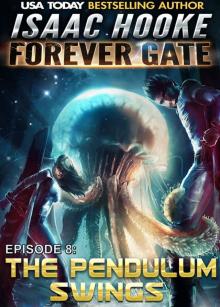 The Pendulum Swings (The Forever Gate Book 8)
The Pendulum Swings (The Forever Gate Book 8) The Link
The Link Just Another Day
Just Another Day Star Warrior
Star Warrior Alien War Trilogy 1: Hoplite
Alien War Trilogy 1: Hoplite Battle Harem 3
Battle Harem 3 The Ethan Galaal Series: Books 1 - 3
The Ethan Galaal Series: Books 1 - 3 Reloaded
Reloaded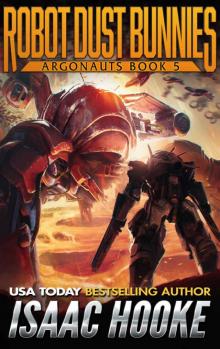 Robot Dust Bunnies (Argonauts Book 5)
Robot Dust Bunnies (Argonauts Book 5) Battle Harem
Battle Harem ATLAS 3 (ATLAS Series Book 3)
ATLAS 3 (ATLAS Series Book 3) Argonauts 2: You Are Prey
Argonauts 2: You Are Prey Worlds at War (A Captain's Crucible Book 5)
Worlds at War (A Captain's Crucible Book 5) Operation: Bug Spray (Argonauts Book 9)
Operation: Bug Spray (Argonauts Book 9) Battle Harem 2
Battle Harem 2 Redeemed (Bolt Eaters Trilogy Book 3)
Redeemed (Bolt Eaters Trilogy Book 3) Atlas
Atlas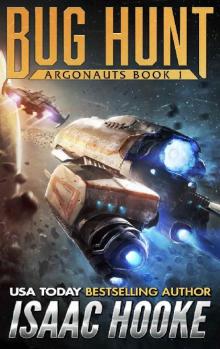 Argonauts 1: Bug Hunt
Argonauts 1: Bug Hunt Reactivated (Bolt Eaters Trilogy Book 1)
Reactivated (Bolt Eaters Trilogy Book 1) Alien War Trilogy 3: Titan
Alien War Trilogy 3: Titan Flagship (A Captain's Crucible #1)
Flagship (A Captain's Crucible #1)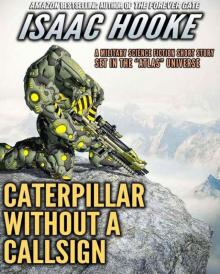 Caterpillar Without A Callsign
Caterpillar Without A Callsign The Forever Gate
The Forever Gate He Who Crosses Death (Star Warrior Quadrilogy Book 3)
He Who Crosses Death (Star Warrior Quadrilogy Book 3) Reforged (Bolt Eaters Trilogy Book 2)
Reforged (Bolt Eaters Trilogy Book 2) Refurbished
Refurbished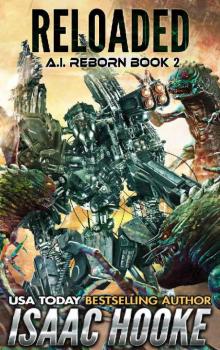 Reloaded (AI Reborn Trilogy Book 2)
Reloaded (AI Reborn Trilogy Book 2) He Who Crosses Death
He Who Crosses Death Explorations: First Contact
Explorations: First Contact Planet Killer (A Captain's Crucible Book 4)
Planet Killer (A Captain's Crucible Book 4) Quantum Predation (Argonauts Book 4)
Quantum Predation (Argonauts Book 4) Clandestine-IsaacHooke-FreeFollowup
Clandestine-IsaacHooke-FreeFollowup The Last Stand (The Forever Gate Book 9)
The Last Stand (The Forever Gate Book 9) City of Phants (Argonauts Book 6)
City of Phants (Argonauts Book 6) Test of Mettle (A Captain's Crucible Book 2)
Test of Mettle (A Captain's Crucible Book 2)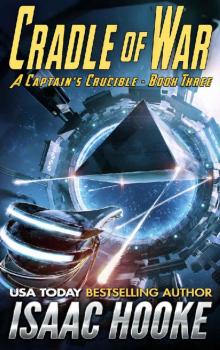 Cradle of War (A Captain's Crucible Book 3)
Cradle of War (A Captain's Crucible Book 3) Rade's Fury (Argonauts Book 7)
Rade's Fury (Argonauts Book 7) Rebirth (The Forever Gate Book 6)
Rebirth (The Forever Gate Book 6) The Forever Gate Compendium Edition
The Forever Gate Compendium Edition Mechs vs. Dinosaurs (Argonauts Book 8)
Mechs vs. Dinosaurs (Argonauts Book 8) Alien War Trilogy 2: Zeus
Alien War Trilogy 2: Zeus ATLAS 2 (ATLAS Series Book 2)
ATLAS 2 (ATLAS Series Book 2) Operation_Bug Spray
Operation_Bug Spray